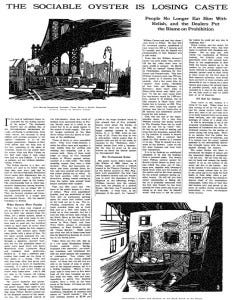The Sociable Oyster is Losing Caste
Prohibition didn’t just ban alcohol, it also decreased the popularity of certain foods often eaten alongside alcohol, such as oysters. A 1925 New York Times Magazine article detailed the second-degree effect.
An article with no byline began:
Is the lack of legitimate liquor responsible for the failing market of the oyster? The wholesale dealers say so…
…
Dealers in New York affirm that the long arm of the law… wiped out the public taste for oyster fries and Blue Points on the half shell when it took away beer and ale and Chablis. It is only an opinion, yet not without substantiating evidence. The failing market is a fact.
The article ended:
It was useless to have planted young oysters four or five or six years ago to be ready for half shells or fries today, when a perverse public meantime has elected to deprive itself of the concomitant champagne, white wine, or beer that had become part and parcel of the savor of oysters during unreckoned generations in every sea-bordered white country.
So why didn’t the oyster market rebound after Prohibition?
An article from Michigan State University’s Campus Archaeology Program notes: “New Yorkers in the 1800s ate an average of 600 oysters per year, today Americans eat an average of less than three oysters per year.” The article explains the various contributing factors including:
Overfishing: with far fewer oysters, their price skyrocketed to the point that they’re now considered a delicacy. The article noted that oysters used to be consumed en masse by both upper-class and lower-class alike.
Health scares: A 1924 Chicago typhoid outbreak was tied to bad oysters, plummeting their popularity across the country. Curiously, though, this 1925 New York Times Magazine article only a year later didn’t seem to list this as a factor.
Prohibition closing bars: The article also says that bar closures during the 1920s meant there weren’t nearly as many establishments which potentially even could serve oysters by the 1930s. Not sure I fully buy this explanation, though? After all, a full century later, there are now bars aplenty… and yet oysters still aren’t nearly as popular as they once were.
Personally, I’ve had oysters a few times at seafood restaurants and enjoyed them well enough… but I’m closer to the American average of three per year. Honestly, maybe not even that.
The Sociable Oyster is Losing Caste: People No Longer Eat Him With Relish, and the Dealers Put the Blame on Prohibition
Published: Sunday, July 26, 1925


